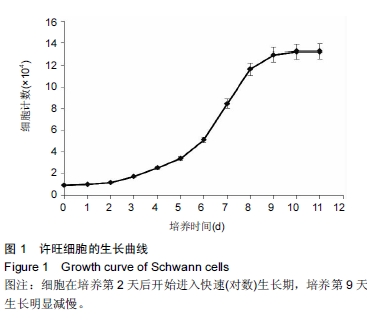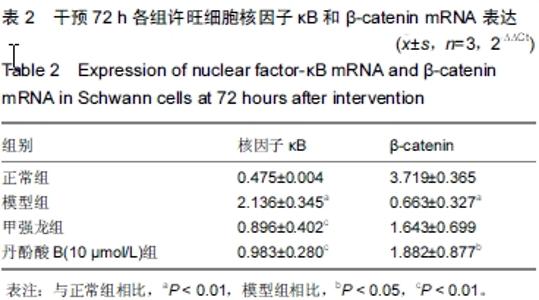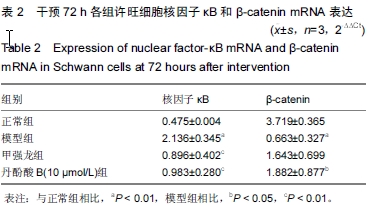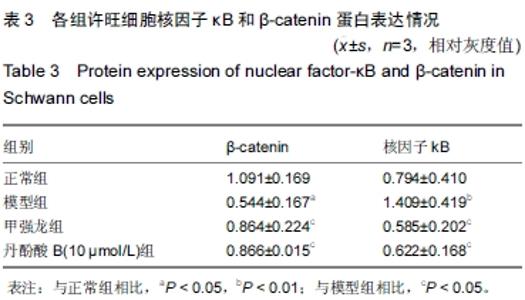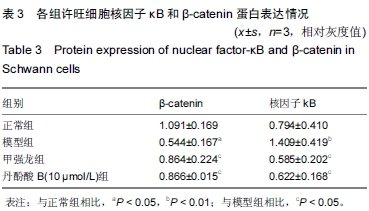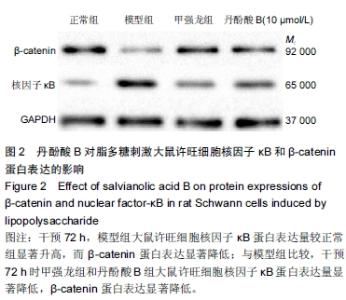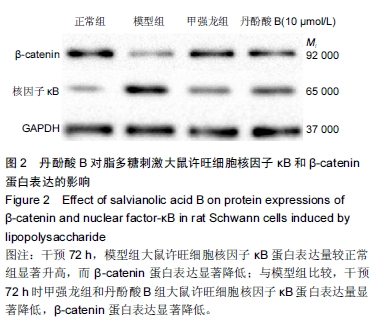Chinese Journal of Tissue Engineering Research ›› 2015, Vol. 19 ›› Issue (42): 6813-6818.doi: 10.3969/j.issn.2095-4344.2015.42.017
Previous Articles Next Articles
Neuroprotective effects of salvianolic acid B against Schwann cell injury induced by lipopolysaccharide
Bi Lian-yong
- Dongzhimen Hospital Affiliated to Beijing University of Chinese Medicine, Beijing 100700, China
-
Online:2015-10-08Published:2015-10-08 -
Contact:Bi Lian-yong, Dongzhimen Hospital Affiliated to Beijing University of Chinese Medicine, Beijing 100700, China -
About author:Bi Lian-yong, Associate chief physician, Dongzhimen Hospital Affiliated to Beijing University of Chinese Medicine, Beijing 100700, China -
Supported by:Tissue Engineering; Salvia miltiorrhiza; Spinal Cord Injuries; Lipopolysaccharides
Cite this article
Bi Lian-yong. Neuroprotective effects of salvianolic acid B against Schwann cell injury induced by lipopolysaccharide[J]. Chinese Journal of Tissue Engineering Research, 2015, 19(42): 6813-6818.
share this article
| [1] Stephan K, Huber S, Haberle S, et al. Spinal cord injury-incidence, prognosis, and outcome: an analysis of the Trauma Register DGU. Spine J. 2015;15(9):1994-2001. [2] Jazayeri SB, Beygi S, Shokraneh F, et al. Incidence of traumatic spinal cord injury worldwide: a systematic review. Eur Spine J. 2015;24(5):905-918. [3] Ydens E, Lornet G, Smits V, et al. The neuroinflammatory role of Schwann cells in disease. Neurobiol Dis. 2013;55:95-103. [4] Terenghi G. Peripheral nerve regeneration and neurotrophic factors. J Anat. 1999;194(Pt 1):1-14. [5] Fawcett JW, Asher RA. The glial scar and central nervous system repair. Brain Res Bull. 1999;49(6):377-391. [6] Richner M, Ulrichsen M, Elmegaard SL, et al. Peripheral nerve injury modulates neurotrophin signaling in the peripheral and central nervous system. Mol Neurobiol. 2014; 50(3):945-970. [7] Grigoryan T, Birchmeier W. Molecular signaling mechanisms of axon-glia communication in the peripheral nervous system. Bioessays. 2015;37(5):502-513. [8] 时素华,李志刚,秦丽娜,等.脊髓损伤相关信号通路及中医药治疗研究[J].北京中医药,2014,33(4):308-310. [9] 吴俊哲,王伟群,曾元桂,等.中医药治疗脊髓损伤及骨质松疏的研究进展[J].中药材,2014,37(9):1699-1702. [10] 赵先,王婧雯,陆杨,等.丹酚酸B药理作用的研究进展[J].西北药学杂志,2015,30(1):107-110. [11] 马萌萌,郭虹,张晗,等.丹酚酸B对脑损伤神经细胞的保护作用[J].天津中医药大学学报,2015,34(1):55-58. [12] 杨春壮,刘长发,杨春佳.丹参注射液治疗急性脊髓损伤疗效观察[J].中医药信息,2003,20(6):36. [13] 侯建雄,马海燕,李莉.前后路联合手术配合丹参注射液治疗颈椎骨折伴脊髓损伤临床观察[J].河北医药,2013,35(12):1872-1874. [14] Shu T, Pang M, Rong L, et al. Protective effects and mechanisms of salvianolic acid B against H(2)O(2)-induced injury in induced pluripotent stem cell-derived neural stem cells. Neurochem Res. 2015;40(6):1133-1143. [15] 荀翀.丹酚酸B在脊髓损伤中的作用及其相关机制的实验研究[D].大连:大连医科大学,2014. [16] Wang Y, Jiang YF, Huang QF, et al. Neuroprotective effects of salvianolic acid B against oxygen-glucose deprivation/ reperfusion damage in primary rat cortical neurons. Chin Med J (Engl). 2010;123(24):3612-3619. [17] Xun C, Hu Y, Lu M, et al. Study of effect of salvianolic acid B on motor function recovery in rats with spinal cord injury. Biomed Res Int. 2014;2014:931850. [18] Tao YY, Wang QL, Shen L, et al. Salvianolic acid B inhibits hepatic stellate cell activation through transforming growth factor beta-1 signal transduction pathway in vivo and in vitro. Exp Biol Med (Maywood). 2013;238(11):1284-1296. [19] 谭志强.甲强龙冲击疗法对急性颈脊髓损伤的临床研究[J].中国医学创新,2014,11(34):73-76. [20] Costa DD, Beghi E, Carignano P, et al. Tolerability and efficacy of erythropoietin (EPO) treatment in traumatic spinal cord injury: a preliminary randomized comparative trial vs. methylprednisolone (MP). Neurol Sci. 2015;36(9):1567-1574. [21] 朱庄臣,焦伟,蔡国栋,等.大剂量甲强龙治疗急性脊髓损伤后早期并发症的研究[J].中国矫形外科杂志,2014,22(16):1454-1457. [22] 周孝斌,李志忠,孙国栋.许旺细胞在脊髓损伤中的研究进展[J].海南医学,2014,25(7):1004-1007. [23] Cameron AA, Vansant G, Wu W, et al. Identification of reciprocally regulated gene modules in regenerating dorsal root ganglion neurons and activated peripheral or central nervous system glia. J Cell Biochem. 2003;88(5):970-985. [24] Sun L, Pan J, Peng Y, et al. Anabolic steroids reduce spinal cord injury-related bone loss in rats associated with increased Wnt signaling. J Spinal Cord Med. 2013;36(6):616-622. [25] Briona LK, Poulain FE, Mosimann C, et al. Wnt/ss-catenin signaling is required for radial glial neurogenesis following spinal cord injury. Dev Biol. 2015;403(1):15-21. [26] 梁新军,吴燕峰,唐勇,等.大鼠脊髓损伤后Wnt信号分子的表达变化[J].中国脊柱脊髓杂志,2009,19(12):931-934. [27] 李雪鹏.脊髓损伤后肌成束蛋白(FSCN1)的表达与功能分析[D].长春:吉林大学,2014. [28] 韦竑宇,梁立.他莫昔芬对大鼠脊髓损伤后炎性反应及细胞凋亡的影响[J].中国医药导报,2014,11(34):23-26. [29] 陈凯,张俐.丹参及其制剂对脊髓损伤的保护作用及机制研究概况[J].中华中医药杂志,2012,27(11):2887-2890. [30] 周秀梅,陈龙,邵一叶,等.microRNA-146a在LPS诱导的大鼠许旺细胞损伤模型中的表达[J].中国临床医学,2015,22(3):288-290. [31] Witcher KG, Eiferman DS, Godbout JP. Priming the Inflammatory Pump of the CNS after Traumatic Brain Injury. Trends Neurosci. 2015;38(10):609-620. [32] Lee DH, Steinacker P, Seubert S, et al. Role of glial 14-3-3 gamma protein in autoimmune demyelination. J Neuroinflammation. 2015;12(1):187. [33] Alkabie S, Boileau AJ. The role of therapeutic hypothermia after traumatic spinal cord injury-a systematic review. World Neurosurg. 2015. [34] Kabu S, Gao Y, Kwon BK, et al. Drug delivery, cell-based therapies, and tissue engineering approaches for spinal cord injury. J Control Release. 2015. [35] Sanna MD, Stark H, Lucarini L, et al. Histamine H4 receptor activation alleviates neuropathic pain through differential regulation of ERK, JNK and P38 MAPK phosphorylation. Pain. 2015. [36] Madathil SK, Saatman KE. IGF-1/IGF-R Signaling in Traumatic Brain Injury: Impact on Cell Survival, Neurogenesis, and Behavioral Outcome. In: Kobeissy FH, editor. Brain Neurotrauma: Molecular, Neuropsychological, and Rehabilitation Aspects. Boca Raton (FL): CRC Press. 2015. [37] Zhang B, Bailey WM, Braun KJ, et al. Age decreases macrophage IL-10 expression: Implications for functional recovery and tissue repair in spinal cord injury. Exp Neurol. 2015;273:83-91. [38] Xu J, E XQ, Liu HY, et al. Angelica Sinensis attenuates inflammatory reaction in experimental rat models having spinal cord injury. Int J Clin Exp Pathol. 2015;8(6):6779-6785. [39] Alawieh A, Sabra M, Sabra Z, et al. Molecular Architecture of Spinal Cord Injury Protein Interaction Network. PLoS One. 2015;10(8):e0135024. [40] Bastien D, Bellver Landete V, et al. IL-1α Gene Deletion Protects Oligodendrocytes after Spinal Cord Injury through Upregulation of the Survival Factor Tox3. J Neurosci. 2015; 35(30):10715-10730. [41] Wang J, Pearse DD. Therapeutic hypothermia in spinal cord injury: the status of its use and open questions. Int J Mol Sci. 2015;16(8):16848-16879. [42] Quinzaños-Fresnedo J, Sahagún-Olmos RC. Micro RNA and its role in the pathophysiology of spinal cord injury-a further step towards neuroregenerative medicine. Cir Cir. 2015; 83(5):442-447. [43] Ansari MA. Temporal profile of M1 and M2 responses in the hippocampus following early 24h of neurotrauma. J Neurol Sci. 2015;357(1-2):41-49. [44] Impellizzeri D, Ahmad A, Di Paola R, et al. Role of Toll like receptor 4 signaling pathway in the secondary damage induced by experimental spinal cord injury. Immunobiology. 2015;220(9):1039-1049. [45] Guo L, Quan ZX, Zhao ZH, et al. Effects of musk ketone on nerve recovery after spinal cord injury. Genet Mol Res. 2015; 14(2):2958-2963. [46] Goldshmit Y, Kanner S, Zacs M, et al. Rapamycin increases neuronal survival, reduces inflammation and astrocyte proliferation after spinal cord injury. Mol Cell Neurosci. 2015; 68:82-91. |
| [1] | Ma Hongwei, Liu Panyun, Zhang Yaqiong. Ginsenoside-induced bone marrow mesenchymal stem cell intervention can affect healing and Wnt/beta-catenin signaling in rats with diabetic skin ulcer [J]. Chinese Journal of Tissue Engineering Research, 2019, 23(33): 5300-5306. |
| [2] | Li Weiming, Sun Dali, Li Yijun, Li Shumin, Sun Yanbo, Cui Jin, Xu Pengyuan, Xu Qingwen. Deep seawater promotes cutaneous wound healing in diabetic mice via activating Wnt/β-catenin pathway [J]. Chinese Journal of Tissue Engineering Research, 2019, 23(31): 5017-5022. |
| [3] | Xiang Xiaona, Yu Xi, Liu Yan, Jiang Hongying, He Chengqi, He Hongchen. Pulsed electromagnetic fields and platelet rich plasma therapy for treatment of osteoarthritis: theoretical progress and clinical research [J]. Chinese Journal of Tissue Engineering Research, 2019, 23(30): 4868-4874. |
| [4] | Shen Qian, Hu Peixin, Zhong Shuxian, Yang Yalan, Zhang Saixia, Li Chun. Tortoise shell ointment for acute skin wound in rats via Wnt/beta-catenin signal pathway in hair follicle stem cells Tortoise shell ointment for acute skin wound in rats via Wnt/beta-catenin signal pathway in hair follicle stem cells [J]. Chinese Journal of Tissue Engineering Research, 2019, 23(29): 4668-4674. |
| [5] |
Fu Yin, Sun Guicai, Tu Yuanqing, Ling Xiaopeng.
Lithium chloride promotes proliferation and differentiation of bone marrow mesenchymal stem cells via Wnt/beta-catenin signaling pathway
[J]. Chinese Journal of Tissue Engineering Research, 2019, 23(25): 3956-3960.
|
| [6] | Liu Jinjuan1, Yang Hongfa2, Li Yongjian1, Chen Yanming1. Effects of the intervention of Wnt/beta-catenin signaling pathway on skin tissue fibrosis and epithelial-mesenchymal transition in mouse models of scleroderma [J]. Chinese Journal of Tissue Engineering Research, 2019, 23(23): 3680-3685. |
| [7] | Li Zhongxian, Ji Yucheng, Weng Yujie, Ning Pengfei. Manipulation analysis of Mongolian osteopathy based on finite element model of ulna and radius [J]. Chinese Journal of Tissue Engineering Research, 2019, 23(20): 3153-3157. |
| [8] | Cai Guo-liang, Qu Jin-tao, Sun Jun-zhi,Zhuang Zhe, Cai Guo-feng. Evidence-based sports medicine: definition, background, development and practice [J]. Chinese Journal of Tissue Engineering Research, 2015, 19(51): 8338-8343. |
| [9] | Mao Yu-rong, Chen Na, Chen Pei-ming, Chen Song-bin, Li Li-fang, Huang Dong-feng. Three-dimensional motion analysis of dominant and nondominant hands under weight-bearing conditions in health elderly people [J]. Chinese Journal of Tissue Engineering Research, 2015, 19(42): 6776-6781. |
| [10] | Dong Ming, Liu Dong, Liang Yun-hai, Wen Zi-jun, Ma Xiao-yu. Construction of obese mouse models with high fat diet feeding: relationship between nutritional factor and metabolic syndrome [J]. Chinese Journal of Tissue Engineering Research, 2015, 19(40): 6542-6546. |
| [11] | Sun Ming-yu, Yan Cheng-hui, Tian Xiao-xiang, Li Yang, Han Ya-ling. Interactions between the recombinant human CREG protein and cathepsins and M6P/IGFIIR [J]. Chinese Journal of Tissue Engineering Research, 2015, 19(37): 5961-5965. |
| [12] | Liu Xing-zhen, Jin Wen-jie, Shen Kang-ping, Fu Zhi-yi, Wu Yu-jie. Expression of hypoxia-inducible factor 1 alpha and its relationship to apoptosis in human lumbar nucleus pulposus [J]. Chinese Journal of Tissue Engineering Research, 2015, 19(33): 5279-5283. |
| [13] | Luo Qing-qing. Effect of Dll4 at different concentrations on the biological functions of extravillous trophoblasts [J]. Chinese Journal of Tissue Engineering Research, 2015, 19(24): 3860-3864. |
| [14] | Tan Yu-lin1, Bao Tong-zhu, Liu Qin, Han Yu, Wang Yan-lin, Liu Yang, Zhou Na-xin, Yan Fei,Zhao Long-tao. Influence of geniposide on collagen II synthesis of cultured chondrocytes in vitro [J]. Chinese Journal of Tissue Engineering Research, 2014, 18(20): 3149-3152. |
| [15] | Chen Hao, Xu Lang. Signal pathway effects on gastric cancer stem cells and gastric cancer occurrence [J]. Chinese Journal of Tissue Engineering Research, 2013, 17(14): 2532-2537. |
| Viewed | ||||||
|
Full text |
|
|||||
|
Abstract |
|
|||||

